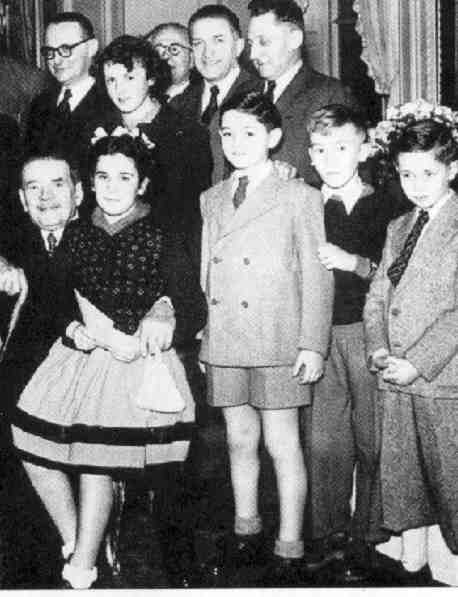
French Short Pants Suits: Post-war Years (1945-69)

Figure 1.--French boys still commonly wore short pants suits after World War II, but suit preferences were highly varried. This 1951 photograph shows a boys wearing short pants, long pants, and knicker suits. (The knickers are so long that they look rather like long pants.) Notice how the boy in the short pants suit has turned down his socks.
|
Shorts were commonly worn by European boys,
even quite old boys through the 1950s. It was quite common for boys' suits to have short pants. While short pants suit were still common after World War II, they wete not universal. Some quite old boys might wear a short panrs suit. On the other hand, some younger boys might wear long pants. There does not appear to have been a lot of easy to identify factors at play. Perhaps social class was a factor. But the primary reason was simply the predelections of the parents. Some parents had definite ideas. Some had no strong feelings on the matter. This changed in the 1960s and by the end of the decade short pants suits were only seen on younger boys.
Chronolgy
The popularity of short panrs suits changed significantly in the post-war era. After the War, boys mostly wore shortpants suits, even older boys. By the late 1960s they had become much less common and were mostly worn by younger boys.
1945-55
Shorts were commonly worn by European boys,
even quite old boys through the 1950s. It was quite common for boys' suits to have short pants. The popularity of short pants suits changed significantly during the 1950s. Short pants suits were still quite common in the early 1950s, but gradually declined during the decade. They began to be worn by younger and younger boys. At the same time styles changed and boys began wearing shorter cut shorts. HBC is not positive what caused this change. One factor appears to have been declining parental authority. Parents began adopting a less authoritative role and allowed their children an increasing rle oin selecting their clothes
1955-69
Changes were notable in the 1960s and by the end of the decade short pants suits were only seen on younger boys. French children by the late 1950s were wearing suits much less than before the war. They rarely wore them to school. They also wanted suits with long pants. Some parents comtinued to insist on shorts, but by the 1960s most parents were buying long pants suits, especially for older boys. The Paris Student Riots of 1968 was a dividing pount between the post-war and late 20th century era. The fashion preferences of older boys for jeans and casual clothes soon filtered down to younger boys.
Conventions
A French HBC contributor confirms this saying that short pants suits were common in the 1950s, although he reports that he did not wear one. This is an important point. While short pants suit were still common after World War II, they wete not universal. Some quite old boys might wear a short pants suit. On the other hand, some younger boys might wear long pants. There does not appear to have been a lot of easy to identify factors at play. Perhaps social class was a factor. But the primary reason was simply the predelections of the parents. Some parents had definite ideas. Some had no strong feelings on the matter.
Style
Double breasted suits were very popular in the 1940s and early 50s, but by thhe 60s most boys wore single breadted suits.
Hosery
French boys wearing short pants suit in the inter-war years almost always wore then with kneesocks. This changed after World War II. Ir became much more common to wear short pants suits with ankle socks, especially during the summer. Ankle socks became increasingly common in the 1960s. Some boys wore their ankle socks turned down in a kind of cuff effect. Younger boys in some neighboring countries (Germany and Switzerland) wore short pants with tights during the winter, but I do not know that this ocurred in France.
Personal Observations
An American HBC contributor that attended a French school for a year reports that to his best recollection in 1964/65, most boys did not wear suits to school. He recalls one boy in another class who always wore exactly the same clothes--a gray short pants suit with knee socks every day. The only difference between winter and summer is that he wore a sweater underneath the jacket in winter. He apparently came from a very traditionally-minded family. He can't clearly remember whether the boy wore, probably not. He did see some short pants suits (and long pants suits) when boys were being confirmed in a near by Catholic Church. He did see more boys wearing shortpants suits when his family traveled to Germany.
Christopher Wagner
histclo@lycosmail.com
Navigate the Boys' Historical Clothing Web Site:
[Return to the Main French shorts pants suit page]
[Return to the Main shorts pants suit page]
[Introduction]
[Chronology]
[Clothing styles]
[Biographies]
[Bibliographies]
[Activities]
[Countries]
[Contributions]
[Boys' Clothing Home]
Created: February 21, 2000
Last edited: February 21, 2000


